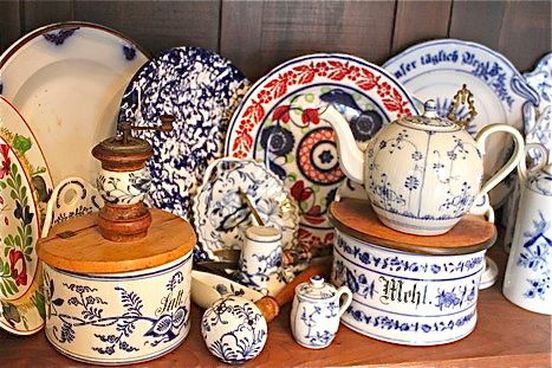|
Years ago when first starting to collect antiques I fell in love with the old German blue and white kitchen dishes of all kinds, much of which were decorated in what is generally known as the Blue Onion (Zwiebelmuster) pattern and also the Straw Flower (Strohblumen) pattern. It was made by literally hundreds of factories in the late 1800s and early 1900s in Germany. My kitchen at that time was even wallpapered in blue and white, so when I renovated my kitchen several years ago the dilemma was what to do with my collection. Many pieces are now stored in cupboards or boxes in the basement, but my favorites are displayed in an old walnut armoire I fitted with shelves and converted into a display cabinet for my little collections. Of course, the most common of the pieces are the salt and flour containers, tenderizing mallets, scoops, pepper mill and plates, but I soon developed a thing for pieces labeled in old German script, the rarer the better. Here a grater and child's size slaw cutter (Krauthobel) are displayed with breakfast boards (Frühstücksbrettchen) which usually either extol the virtues of home and hearth or give men advice on figuring out a woman. I always look for unusual sayings. The one on the right says, "Whoever has sausage, bread and ham will always be satisfied." Of course, I couldn't resist collecting these containers with old German script and figural sauage handles, even if they don't have the blue onion pattern. From left to right they are for "Little Sausages," Warm Little Sausages" and "Hot Little Sausages." The marinated herring container is a foot long and has a lifelike figural herring as a handle. I would think even those that can't read old German script, or any German at all for that matter, will know what this is for!  This is one of my most recent finds. Display space is almost nonexistent, but this Villeroy and Boch piece is extremely rare, and I couldn't resist. Can you guess what it is? A toothbrush rack! And down below is a holder for "tooth powder" (Zahnpulver). I'm guessing there MAY have been a lid to cover the tooth powder because of the ridge all the way around, but I've never seen another like it, so I can't be sure.  I generally don't buy kitchen canisters, but this is labeled "Kartoffelmel" (Potato Flour), which is a rarity (also, the "mel" is spelled without the H, indicating a very early piece).
4 Comments
Leave a Reply. |
Archives
May 2015
Susan's PageWelcome to Living Tastefully’s “Antique of the Week” page. Our love of antiques is reflected in every aspect of our everyday lives. We are passionate about collecting and also love functional antiques that can actually be used and not only admired. Hopefully we can inspire you to incorporate antiques in your home and your life to add charm and beauty to your surroundings.
All
Links
|






 RSS Feed
RSS Feed